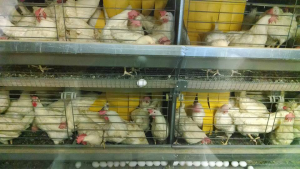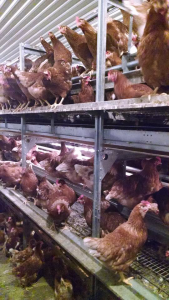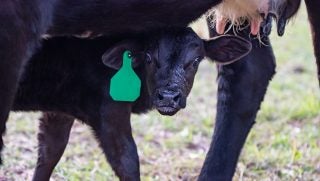Most of us who eat meat/eggs care about health and animal welfare, right? In a day and age where we are bombarded with marketing tactics, is it really worth it to spend $6 a dozen for eggs? Not everyone can afford this, so let’s explore the claims of egg labels and see whether it’s really better for the chickens.
Recently, I had the privilege of touring Canada’s largest egg farm, Burnbrae Farms. Their standards are pretty comparable to the U.S., and I was able to see most of the different types of hen houses firsthand, while learning and working alongside industry professionals who have devoted their entire lives to egg production. Here I share the pros and cons of each egg laying system to help guide you on what labels really mean to help you make the best decision for your ideals and budget.
1. Conventional caged: Conventionally caged eggs have about 5 hens in a cage to which their basic needs (food, water, climate-controlled shelter) are met. They are on a flooring where their droppings can fall through and used for recycled fertilizer, but eggs are rolled down onto a conveyor system for processing. This is the easiest way to monitor their health, keep their bodies and eggs clean, and prevent feather plucking, all while providing a quality product with the lowest carbon footprint and lowest price. Ninety percent of eggs in the world currently come from these housing systems, and space per bird usually ranges in the 67- to 90-square-inch range.
2. Enriched caged: This is my favorite housing system. It takes the conventional cage a step further by providing nesting boxes, scratch pads, and perches. The cages are bigger and house between 10 and 100 birds, with 80 to 116 square inches of space per bird. They have a little more room to roam and is the “new” way to cage chickens, supported by animal science experts like Temple Grandin.

3. Cage free: (AKA “free run” in Canada) Here they have a large pen to run around in, are free to fly and jump about, climb up ramps, roll in dust. Spacing here is 1.0 to 1.2 square feet per bird. Despite the fact they have more room to roam, the expression “birds of a feather flock together” is a legit one, and they still seem to huddle up together regardless. The downfall to systems like this is there is more feather plucking, higher mortality rate, and more risk of injury. Chickens are not the most intelligent creatures (sorry, sweet chickens) and will sometimes crush each other to death and won’t always connect to the ground on their leaps, therefore they can break their breastbones. They are not separated from manure, but can take dust baths. They don’t always lay eggs where they are supposed to, so this can create food safety or quality issues due to a higher likelihood of dirty eggs. It also requires three times more labor and there is more dust, thus making conditions for workers less than ideal.

4. Free range: In addition to everything listed in the “free run” system above, the difference here is that the birds have some access to the outdoors. They don’t always choose to use it though; they seem to prefer to stay indoors in a climate-controlled environment. Chickens are not humans. They have different needs, and when they’re outside, they’re more susceptible to disease, predators, and weather elements. There isn’t as much biosecurity here, and mortality rate is even higher, while the eggs may not be as clean or easy to collect. It does appeal to emotion though, and the higher pice tag is warranted for higher bird loss and more expensive heating, cooling, and infrastructure costs. Nearly 1 in 5 chickens in a free range system dies before it ever reaches market. Predators are jerks.
5. Pasture raised: Everything listed in the free range category applies to the pasture raised label, except that they spend most of their lives outside on grass. This paints a pretty picture to the consumer, but this makes them very susceptible to predation and weather elements. Remember, summer can pose some very serious heat. We get tornadoes, rain, hail, insect infestation and other diseases. And what are they supposed to do in a snow covered sub-zero winter? Chickens on these systems don’t have as much control over their diets and will also eat anything, including particles out of poop! Oh my.
6. Organic: Organic takes it a step further and has different types of feed ingredients. No genetically engineered feeds are permitted, which makes raising organic chickens extremely expensive. Organic chickens are also required a 1.8 square foot space per bird, as compared to 1.2 square feet per bird in free run.
So there you have it. On one hand you have some marketing labels that make it sound very “pretty” to the consumer, but is that price point justifiable? Remember, I’m talking about large scale production here and not your small backyard flock. On the other hand, you have a more traditional, controlled environment with a 4 percent mortality rate (instead of 18 percent) with a much lower price point. From a sustainability perspective, we need to be able to affordably feed more people with fewer resources while producing less waste. In my opinion, for large scale production I would prefer a temperature controlled environment, where they are protected from predators and weather elements and cost 99 cents instead of $6 a dozen — but that’s just me. Thankfully we live in a place where we have a lot of choices and if you prefer something else you have that option, and that is great!
Lastly, you can read the article I wrote here that discusses labels like “vegetarian fed, no hormones added, and antibiotic free.” By law, hormones and steroids are not permitted to be added to any poultry feeds, chickens are omnivorous by nature, and antibiotics are not used in egg laying chicken production unless they are sick. All meat, milk, and eggs are antibiotic free due to withdrawal times. Hope this helps to crack open the real eggsplanation of egg labels!
Did you like what you read? Sign up here in a heartbeat to get the best from AGDAILY.com!



